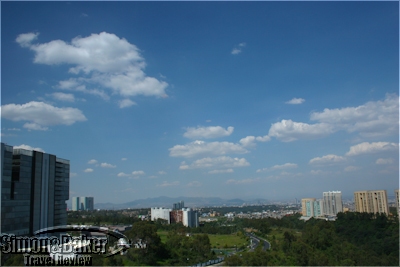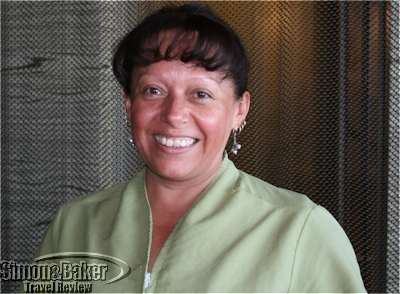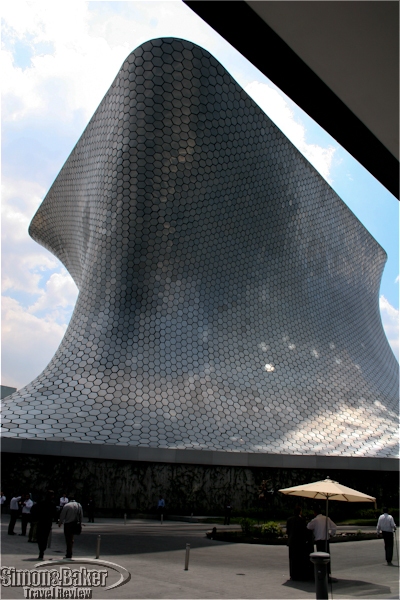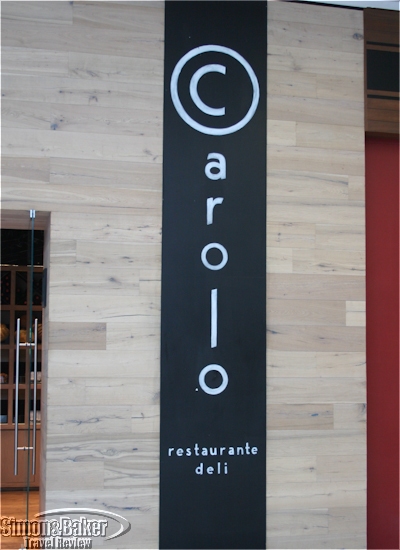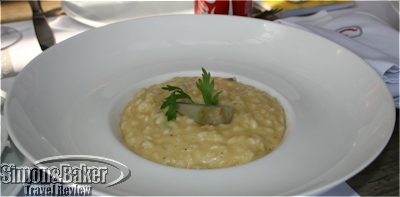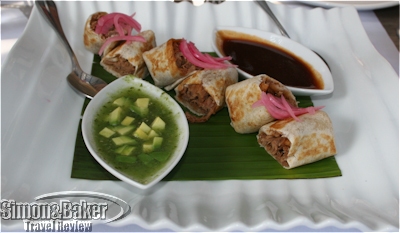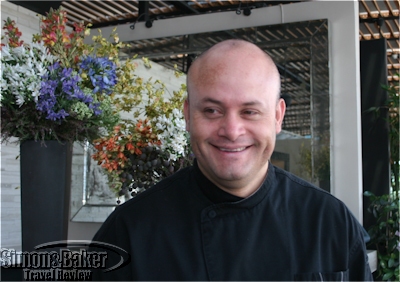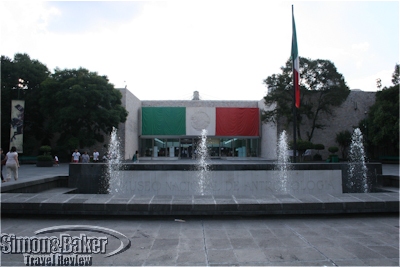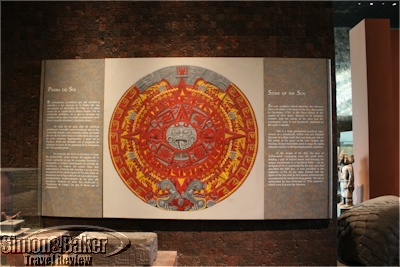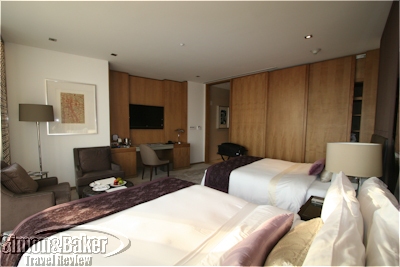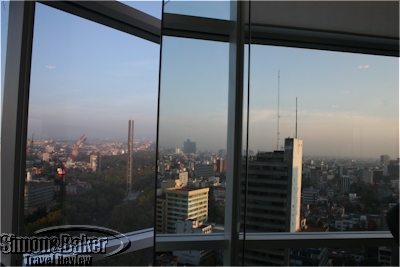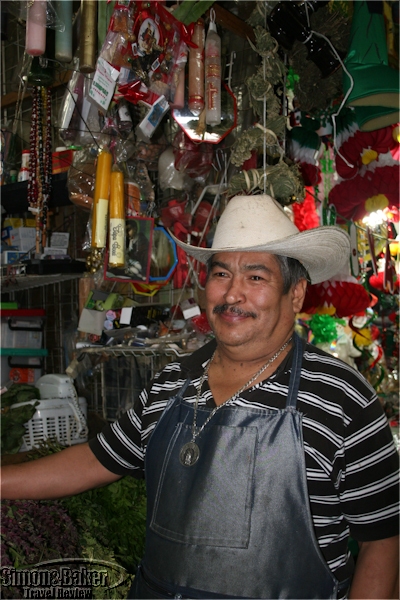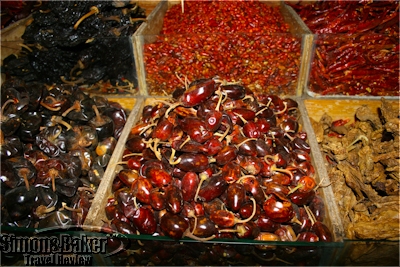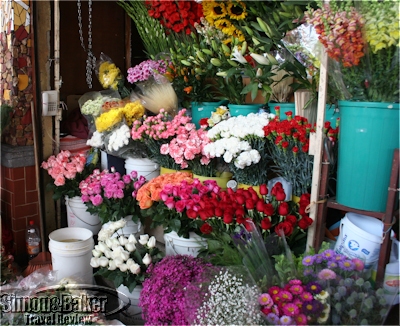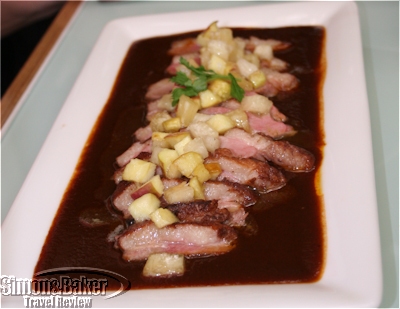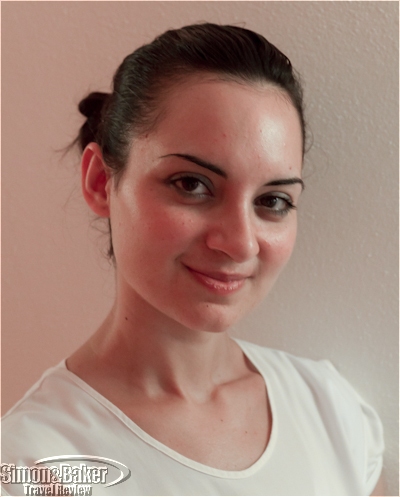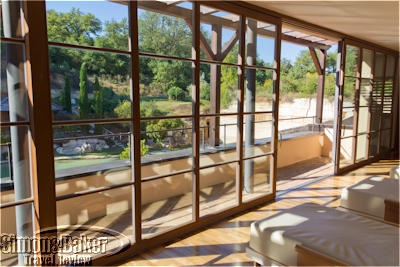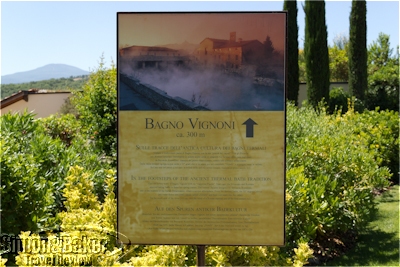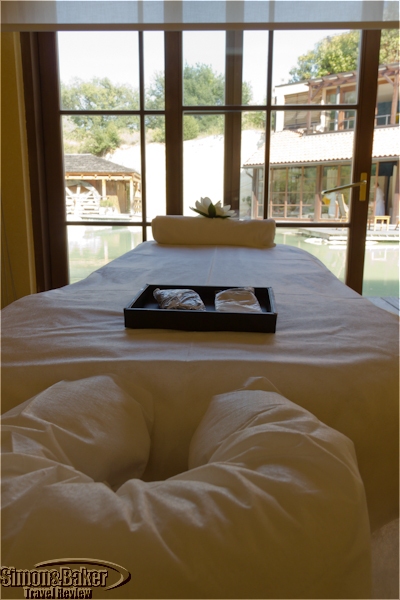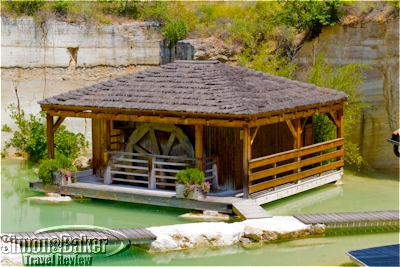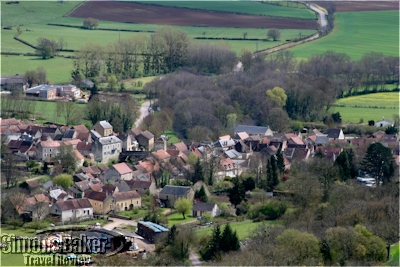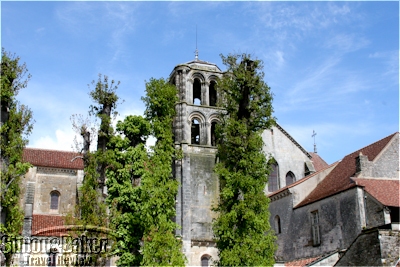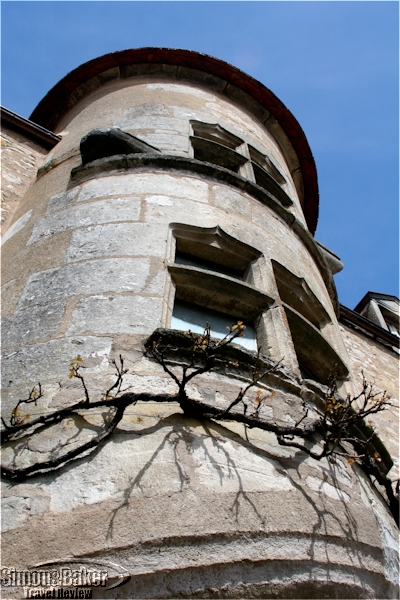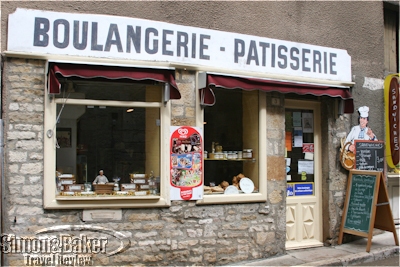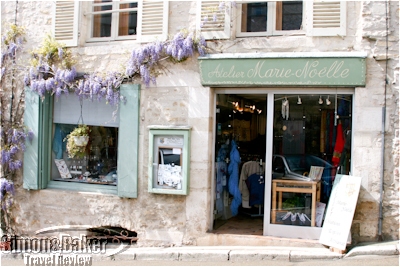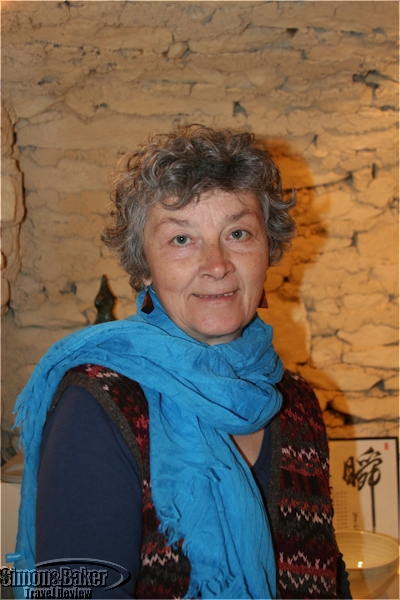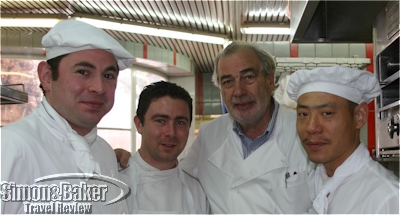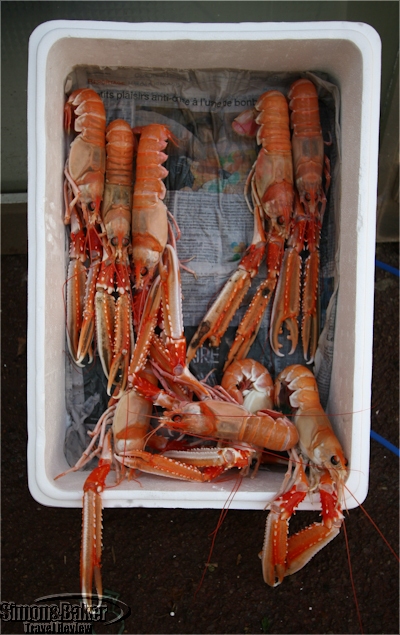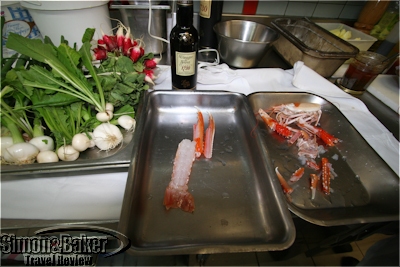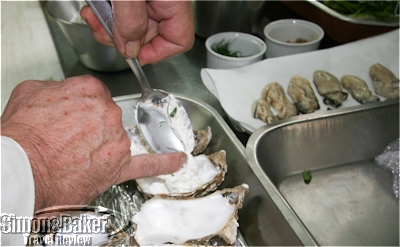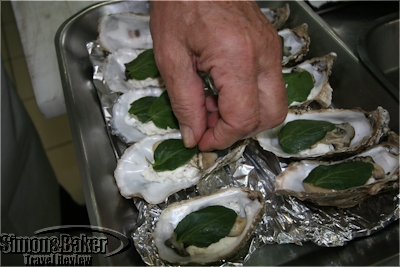Podcast interview with Marc Meneau, executive chef, L Esperance Marc Meneau
Audio translation by Christine Lissac
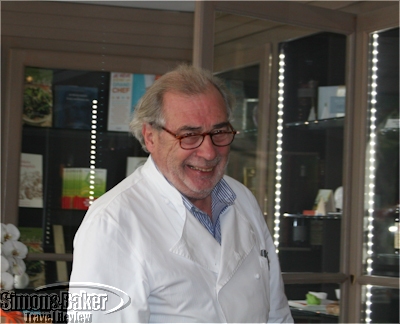
Chef Marc Meneau at Domaine de L’Espérance de Marc Meneau, his hotel and restaurant in Burgundy, France
Listen to a podcast audio interview, in French (see written English translation below), with Marc Meneau, executive chef, L’Espérance Marc Meneau. Earlier this year he discussed his restaurant, one of the best known gourmet French restaurants in Burgundy, and other culinary issues with Elena del Valle, host of the Simon & Baker Travel Review Podcast program, while she was at Domaine de L’Espérance de Marc Meneau in Burgundy, France.
To listen to the interview, click on the play button below
Interview translation:
EDV: So how do you cook?
MM: With love… I begin by reflecting a little bit on the manner in which I was fed in my childhood: with simple products. And I have always kept this traceability of a simple product, never sophisticated with six or seven different flavors in the same plate. I do not know how to do that.
I began to cook later in life after marrying a beautiful blonde whose parents were in the restaurant business and whose mother was a chef and so my wife coaxed me along that line. Eventually we began to consult cookbooks together. I was not a cook back then; we selected some recipes, some words, we did comprehensive research and it was with a document we wrote that we taught ourselves how to cook. And I am still learning, I have been for the past 45 years, I am a perpetual chef apprentice, therefore I observe with great attention all that happens around the world, draw my own conclusions, then continue on my own merry way.
EDV: What are you looking for when you cook? Why do you cook?
MM: Two things need respect. You need to respect the product: if you have carrots, once cooked they must smell like carrots, not smell like cumin or fennel; they must smell like carrots. The second thing is that cooking provides to the one who creates it, the opportunity to share what has been prepared, to present to someone the opportunity, the pleasure of eating well.
I believe these two things are of equal importance. Sometimes the product is more important, sometimes giving to others the pleasure to eat is more important. I have to admit that this inspires me to constantly come up with new recipes, invent new dishes. It is like walking along a little country road leading to Mount Olympus that I will never reach because my arms are too short.
EDV: How do you see this path of yours? The past and the future, as a French chef, what do you see?
MM: My motto is to only think about only 15 minutes into the past and to see the future over a period of a hundred years.
EDV: And what do you think about French Cuisine in the world?
MM: There was a time when French Cuisine was attacked at its very core about 10 years ago, though the one who invented a new form of French cuisine, Adria in Spain, was swallowed up and placed in the forefront in the U.S.A. where the American media thought they had found the world’s genius, without any second thoughts to the possible health consequences that this would have. Adria was a real genius but the public was too interested in “show” cuisines and the media overdid the idea to the point that it became only a Cuisine for Chefs, for those who have fun discovering new flavors, new textures, new technology.
It is not like cooking from memory; it is not like celebrating Grandma’s birthday or your child’s first communion. It is not family cooking; it is a “show” cuisine that was fabulously interesting for us chefs.
Certain French media took pleasure in thrashing out French Cuisine but it was clearly those that were less talented. French cuisine can exist without any problem next to Spanish cuisine, Italian cuisine, Vietnamese cuisine and Chinese cuisine. It is quite possible for all of us to live side by side as our cultures are very complementary to one another.
Each time a recipe exists, there is a story behind it, linked to the culture of each people, each civilization.
EDV: And when you think about what you are doing here in your restaurant, what do you see? Who is the person that is going to be satisfied having a meal here?
MM: This client must be a little like me. He must be someone who knows what a grain of salt and a grain of pepper are and he must also have a grain of imagination; this is how we are going to meet: the client at the table and me at the stove, giving someone an emotion that will become a memory in his life and remind him of his childhood. He could say “yes I have tasted carrots prepared this way with a similar taste twenty years ago.” Even if it is not exactly the same the important part is the memory retained at the time. This is how cuisine becomes a revealing mechanism of life’s emotions.
EDV: Does that person need to be French?
For millennia now cooking has become an international thing, it does not have a country, a color, it is only the expression of how people live on a particular territory. Life is lived differently whether you live in Africa, Asia Minor or Northern Europe. Therefore each country will have its own traditions.
Here is a simple example: Meat can be grilled using old vine logs or pine wood from the moor, birch wood from the northern country and all these will produce a different flavor. There is going to be identification by methodology that will create a different taste.
EDV: So how do you know how to choose this or that place?
MM: Well that is a choice to be made.
EDV: So we ask advice from the chef. What is the style that you produce in your kitchen?
MM: In order to give advice one has to know the people asking for it. The first time you meet them it is impossible to know them. Therefore one must have clients that become patrons so that after their third visit, their host knows that they like eating ris de veau or prefer a turbot fish to a lobster. All that forms part of the professional experience of those working in the restaurant’s dining room. This is no longer the work of the chef. The chef cooks the type of cuisine that he likes and if some people like his type of cuisine, it is all the better. If some people do not like his cuisine, well then either he commits suicide as Vatel did or he changes his range.
EDV: Would you say that this is Classical French Cuisine?
MM: It is the cuisine of Marc Meneau
EDV: Is it not possible to describe it?
MM: No. Not possible.
It is neither classic nor modern; it is the way people like to eat these days while experiencing an emotion. Whether they only want to eat one dish, prefer to eat quickly; there are appropriate dishes for them to choose, and if they would like to have a feast there are also dishes appropriate for that, if they wish to spend an enjoyable evening, between friends or as a couple, there are dishes suitable for that too. No rules.
EDV: The products – Because we begin with the products – what can you tell me about them?
MM: Without product there is no cooking, one does not need to be a good cook if one has rubbish products. One must only use the best products: good products draw out the chef’s intelligence because once the chef has the notion of the effort required to produce these good products and the respect they deserve he will not cheat with them.
EDV: How do you go about getting good products?
MM: We have a lot of experience in this profession and we personally travel across France ten times a year looking for products.
EDV: And what is available here?
MM: Here we have a countryside blessed by the gods as far as architecture, literature, music, history is concerned yet we have rather humble products with the exception of meat, the Charolais (bovine) and of the river fish, which people do not eat anymore, they don’t like it; these days, people do not eat river fish anymore for a single reason: fish bones, sea fish have less bones.
So, as far as foie gras is concerned, we don’t have any here, we only have ham, we have mushrooms. We are limited in what we have but on the other hand we have fresh herbs every day and condiments of good quality. So we find ham in Spain, foie gras either in Landes or in Alsace. We find poultry in Bresse.
EDV: And this morning you took me to visit… the vegetable garden. So what can you tell me about the vegetable garden?
MM: The vegetable garden is a virtual calendar developing in my head; and when I see the first radishes coming through, the leeks, the first lettuces, the zucchini, the eggplant, the tomatoes. Walking through the vegetable garden every day gives me ideas and inspires me to cook. It is a trigger for ideas and inspirations and at the same time it positions me within the right season, so I almost become an honest man.
EDV: And so you have to work hard to get the products from your place? I believe you have two employees in the garden?
MM: Yes, two employees take care of the garden to allow us to have a beautiful garden with flowers, agreeable and simple without sophistication, and a vegetable garden which will bring back to the minds of those strolling by, memories of their grandmothers, their parents, prompt that get them to recall visits to some beautiful castles. Most importantly, they will begin to think to themselves: “rather than having caviar for lunch I am going to have some of these good old radishes with fresh farm butter,” radishes that would never have seen the inside of a fridge, that would not have been transported by truck and that would have been picked that same morning. That is true luxury.
EDV: Do people appreciate it? Do they realize that when they come and sit at your table?
MM: Yes, we are in a period where people are in the process of rediscovering vegetable gardens and leisure gardens and I encourage everyone who has a little balcony or window to plant a few things there. I think it is awesome … because we know we have a rotation over about 20, 40 days in a year, one can have fun by planting a few lettuces, a few carrots, a few radishes, and the day that you are going to eat your own vegetables, it is going to trigger an explosion of joy which will get you to think “I know why I am human, I know why I live.” My dog is unaware of this.
EDV: This is only available to humans…
MM: To mankind… the privilege of humanity is to have the sense of taste, not intelligence, taste. I don’t think other animals have a sense of taste. We do, we have a sense of taste.
EDV: What is the biggest challenge for you, and for a chef today?
MM: It is to stand firm against all the commercial offers of bad products. Recently a great French label of nutritional products, offered with a lot of colorful pages, some truffles all chopped up with gold leafs mixed in, saying that it would make a dish of risotto or rice “chic” when adding this very expensive product that is actually useless. Either we have truffles or we have gold. Gold is for festivities but it is not nutritious. So one has to resist the pressure of the clients who want to pay less and less for their food because they have so many other financial commitments that did not exist twenty or thirty years ago, but they are all so trendy, to the point that these days the cost of food for consumption is lower. So it is up to us chefs to find a solution to reduce the cost but not at the expense of quality, rather by stimulating our creativity and knowledge and harmonizing them in a recipe that could be very simple as long as it is made with good old products. Flashy components are no longer necessary as they used to be in the eighties and nineties, where one had to eat lobster, caviar, foie gras, etc. That era is over. If we do caviar now it will be an eggplant caviar, no longer the caviar from the sturgeon.
EDV: Why?
MM: Because it is no longer in fashion! The price is not justifiable. Twenty or thirty years ago, the cuisine was … how could I say…a social entertainment, today it is an introspective entertainment: how am I going to eat well, how am I going to avoid processed food that we don’t really know much about like how it is produced. How am I going to manage that? How much time can I invest in my cooking in order to avoid the bland ready-made meals with their standardized taste? There are colorants, artificial sugars in each processed product. People are beginning to discover that when a product is natural it is a little less like Coca Cola.
Because when we have a glass of Coca Cola we need a second one. Where as if we drink an ice tea for instance, it is not necessary to have a second one. This is the difference and therefore the cuisine is going to become like that, an element of cultural sobriety.
EDV: Do you think it’s going to be like that in the near future in five or ten years?
MM: Yes I think so. There will always be …. and this is specific to France…upstream from the chef, people that are producing exceptional products. Those that farm and breed are contributing to the greatest wealth of our culinary capital. Today I believe that carrots or tomatoes farmed through extensive agricultural methods are going to lose ground, they will be less and less chosen for cooking.
EDV: What do you mean by extensive agricultural methods?
MM: It is producing farm products in very large quantity using fertilizers. And I think that we are going to return to the original way of farming fresh products.
EDV: I see, cheaper in higher quantity…
MM: Yes that’s it… because a very big tomato cost one euro and three average size tomatoes cost one euro, and when you eat a big tomato from the garden it is more than enough to satisfy your hunger. You would need three badly cultivated tomatoes to make up for that and you spend the same amount of money.
EDV: Are young people able to recognize that?
MM: Young people educated in that discipline can. As for those who are not… I don’t know what we are going to do with them. I would advise parents to set aside one hour per week cooking for their children, to rediscover life around the table and discussions around a meal where one would say “I bought these potatoes last week while we were away at such and such place…” and they will know they are eating those particular potatoes. So, to have gone out to buy the potatoes, brought them home and stored them in the best possible way until the time comes to peel them and cook them, this calls for respect and those potatoes will not be eaten in the same manner that those purchased from the greengrocer downstairs, or in town, that’s if we cook them in water…if they have not been bought already prepared.
So I believe that people have to return to the way things were. In the eighties, some architect designed kitchens that look like lounges. We need to go back to the homely kitchen.
EDV: Some people say that chefs are artists…
MM: Yes I think so, in a conceptual manner. In the realization of our trade we are artisans and in the conceptual dimension of the research it requires… yes… because we work a little bit like musicians would. They have their musical chords and we have our taste buds chords: sour, sweet, salty, bitter and spicy; with five flavors we make millions and millions of recipes!
EDV: And it is also a visual experience, not only the blending of flavors but you also look after the appearance of your dishes.
MM: Well, nature has provided for us the colors red, yellow, green… blue does not work in food, black, with the exception of truffle and caviar, does not work either. Therefore the color scheme for food remain within primary colors… it is between green, white, red and yellow and that’s where its stops.
EDV: Has the presentation evolved?
MM: Ah yes, presentation has evolved in as much as the portions have become smaller, sauces that were hiding the flavor of food have been removed and replaced by lighter gravies and spices that accompany a dish and they too have become a lot lighter. In forty years, I have witnessed a great evolution, it has been exceptional and with the knowledge I have of France I can say that we have never eaten as well as we do now, never before.
EDV: Recently some people have told me that there were more three-stars restaurants in Japan that in France. Should French restaurants overseas be evaluated in the same manner as French restaurants in France? What is your take on that?
MM: I shall not answer this type of question. Some imbeciles believed that it was better to attribute distinctions outside of the country. It is their choice not mine.
EDV: But the question is: can one eat French cuisine outside of France?
MM: No! The products are not the same. It is heresy. When I see the number of three-star French restaurants in Japan, I say …. pfff! Really, I think those that live in France are truly imbeciles…either that or they do not know the director.
EDV: I also wonder about something else…when I see the work required to own a restaurant, particularly for those that do not form part of a big organization with a lot of money, for those that are independent owners, if you do not have talent, if you do not do a great job… you won’t make it.
MM: Yes, it’s the end for them. There are two types in our line of work that operate at two different paces. There are the great investors and the simple owners like us, those that operate with their heart, their faith and the many number of working hours they invest in it.
EDV: So then I wonder about the next generation… Will they be able to do what you have done? Will they have the spirit to create something out of nothing as you have done with your restaurant? What is your opinion?
MM: So this is a good question, but not one that a man of my age can answer. I can only comment a little about it: the children that have been brought up witnessing all the benefits and all the down sides of our profession will maybe keep in mind the benefits. For instance those benefits will be to be able to go to the Bernardins or Chez Goulue and always have a table ready there even without booking it and not having to pay for it. That is the respect that chefs have between each other. Another benefit is to go somewhere and receive a medal. That makes us proud because after all we are “dramatic” people. After spending 15 hours a day in our business, sometime we love an hour during which we can enjoy being the little king of the moment. I have no problem with that. No, I believe it is human nature that causes even a child or another chef to be interested in this kind of benefit. Those unfamiliar with this sort of thing who have access to the position via cooking, want to imitate their chef. It’s what we call motivation. It’s what we call in French la niaque which means to be strong and determined, with a lot of will power. That person says to himself, “I will do it this way, I will succeed,” and he will in time as his era allows him to. There will always be people with ambition and passion.
EDV: Do you think so?
MM: Yes I do.
EDV: So then there is hope?
MM: Well yes … If we had lived like they did in Russia forty years ago, we would not have had the opportunity to have ambition. But we still live in countries where ambition is not a sin.
EDV: Thank you very much then.

